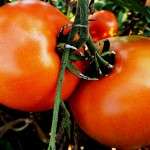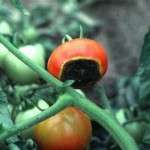Tomato - Our Favorite Veggie
Categories: News
 Let’s take a look at one of our favorite vegetables - tomatoes. The difficulty here is choosing from hundreds of varieties. Let’s narrow it down a little by describing two types of tomatoes, indeterminate and determinate. Indeterminate tomatoes keep growing and getting taller, setting more flowers followed by fruit all summer long. Determinate varieties differ in that as soon as they flower and set “fruit” they stop growing. They are not heavy producers, but the tomato quality is outstanding. Consult a handout or a chart to see whether the variety you are considering is determinate or indeterminate. Another type of tomato that has become increasingly popular is the heirloom tomato. Heirloom varieties are disease resistant and produce some of the tastiest fruit you have ever eaten. If you want to see hundreds of varieties of tomatoes growing locally and taste them as well, go to Wilmington College’s Open House known as Tomadah Prada. The date for this event is normally in mid-August.
Let’s take a look at one of our favorite vegetables - tomatoes. The difficulty here is choosing from hundreds of varieties. Let’s narrow it down a little by describing two types of tomatoes, indeterminate and determinate. Indeterminate tomatoes keep growing and getting taller, setting more flowers followed by fruit all summer long. Determinate varieties differ in that as soon as they flower and set “fruit” they stop growing. They are not heavy producers, but the tomato quality is outstanding. Consult a handout or a chart to see whether the variety you are considering is determinate or indeterminate. Another type of tomato that has become increasingly popular is the heirloom tomato. Heirloom varieties are disease resistant and produce some of the tastiest fruit you have ever eaten. If you want to see hundreds of varieties of tomatoes growing locally and taste them as well, go to Wilmington College’s Open House known as Tomadah Prada. The date for this event is normally in mid-August.
 Some of the problems encountered with tomatoes result from planting tomatoes too early in the spring when the soil is still cool. Blossom end rot is a problem that develops in the tomato plant when calcium, one of the important nutrients in plants, is not able to be absorbed from the soil by the tomato plant. This condition occurs when soil temperatures are too cold and the plant is not able to take up this important element. What we see as a result is a rather large black spot on the bottom end of the tomato. This physiological condition does not affect the flavor of the tomato and the tomatoes are still edible. If this condition occurs later in the season, it is likely due to an uneven moisture supply, going from one extreme to the other- wet to dry. Try to maintain an even moisture level. It is more common when growing tomatoes in containers. If you haven’t had your soil tested in the past couple of years, there is a possibility that there may be a calcium deficiency in your garden soils. A deficiency can be corrected by adding gypsum to your soil. Lime is another good source of calcium, but not usually recommended for our area because of the normally high pH in our soils, unless soil tests indicate otherwise.
Some of the problems encountered with tomatoes result from planting tomatoes too early in the spring when the soil is still cool. Blossom end rot is a problem that develops in the tomato plant when calcium, one of the important nutrients in plants, is not able to be absorbed from the soil by the tomato plant. This condition occurs when soil temperatures are too cold and the plant is not able to take up this important element. What we see as a result is a rather large black spot on the bottom end of the tomato. This physiological condition does not affect the flavor of the tomato and the tomatoes are still edible. If this condition occurs later in the season, it is likely due to an uneven moisture supply, going from one extreme to the other- wet to dry. Try to maintain an even moisture level. It is more common when growing tomatoes in containers. If you haven’t had your soil tested in the past couple of years, there is a possibility that there may be a calcium deficiency in your garden soils. A deficiency can be corrected by adding gypsum to your soil. Lime is another good source of calcium, but not usually recommended for our area because of the normally high pH in our soils, unless soil tests indicate otherwise.
Kick off your growing season by planting several different varieties of tomatoes you haven’t tried before, or stand by your personal favorite. Be sure to plant some of the Sweet Million cherry tomatoes - they taste like candy.
MVG - Growing Sustainably Since 1984




Comments are closed.